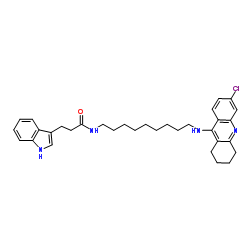Heparinase

Heparinase structure
|
Common Name | Heparinase | ||
|---|---|---|---|---|
| CAS Number | 9025-39-2 | Molecular Weight | 545.158 | |
| Density | 1.2±0.1 g/cm3 | Boiling Point | 795.4±60.0 °C at 760 mmHg | |
| Molecular Formula | C33H41ClN4O | Melting Point | N/A | |
| MSDS | USA | Flash Point | 434.8±32.9 °C | |
|
Differential expression of plasma microRNA in preeclamptic patients at delivery and 1 year postpartum.
Am. J. Obstet. Gynecol. 213 , 367.e1-9, (2015) Preeclampsia (PE) is a hypertensive disorder of pregnancy characterized by widespread maternal endothelial dysfunction. Although clinical signs subside following delivery, long-term risks associated with PE include hypertension, stroke, and cardiovascular dis... |
|
|
Enhanced soluble expression of recombinantFlavobacterium heparinumheparinase I inEscherichia coliby fusing it with various soluble partners
Protein Expr. Purif. 83(2) , 169-76, (2012) Highlights ► IF2 and SUMO can significantly improve the soluble expression of HepA. ► The fusion proteins can be conveniently purified by a single step of IMAC. ► Fusion proteins of HepA retain their biological activity. ► Native HepA can be obtained by effic... |
|
|
Heparin from bovine intestinal mucosa: glycans with multiple sulfation patterns and anticoagulant effects.
Thromb. Haemost. 107(5) , 903-15, (2012) Pharmaceutical grade heparins from porcine intestine and bovine lung consist mainly of repeating tri-sulfated units, of the disaccharide →4-α-IdoA2S-1→4-α-GlcNS6S-1→. Heparin preparations from bovine intestine, in contrast, are more heterogeneous. Nuclear mag... |
|
|
Heparin strongly induces soluble fms-like tyrosine kinase 1 release in vivo and in vitro--brief report.
Arterioscler. Thromb. Vasc. Biol. 31(12) , 2972-4, (2011) Soluble fms-like tyrosine kinase 1 (sFlt1) is involved in the pathophysiology of preeclampsia and coronary artery disease. Because sFlt1 has a heparin-binding site, we investigated whether or not heparin releases sFlt1 from the extracellular matrix.We measure... |
|
|
Overall sulfation of heparan sulfate from pancreatic islet β-TC3 cells increases maximal fibril formation but does not determine binding to the amyloidogenic peptide islet amyloid polypeptide.
J. Biol. Chem. 287(44) , 37154-64, (2012) Islet amyloid, a pathologic feature of type 2 diabetes, contains the islet β-cell peptide islet amyloid polypeptide (IAPP) as its unique amyloidogenic component. Islet amyloid also contains heparan sulfate proteoglycans (HSPGs) that may contribute to amyloid ... |
|
|
The enzymatic degradation of heparin and heparitin sulfate. 3. Purification of a heparitinase and a heparinase from flavobacteria.
J. Biol. Chem. 245(22) , 6170-5, (1970)
|
|
|
Differential binding patterns to host cells associated with particles of several human alphapapillomavirus types.
J. Gen. Physiol. 91 , 531-40, (2010) The focus of this research was to compare the binding profiles of human papillomavirus (HPV) 11, 16, 18 and 45 virus-like particles (VLPs) to HaCaT cells and to the extracellular matrix (ECM) secreted by these cells. All four HPV types tested bind to a compon... |
|
|
Isolation of biologically-active exosomes from human plasma.
J. Immunol. Methods 411 , 55-65, (2014) Effects of exosomes present in human plasma on immune cells have not been examined in detail. Immunological studies with plasma-derived exosomes require their isolation by procedures involving ultracentrifugation. These procedures were largely developed using... |
|
|
Coagulation factors IX and X enhance binding and infection of adenovirus types 5 and 31 in human epithelial cells.
J. Virol. 83(8) , 3816-25, (2009) Most adenoviruses bind directly to the coxsackie and adenovirus receptor (CAR) on target cells in vitro, but recent research has shown that adenoviruses can also use soluble components in body fluids for indirect binding to target cells. These mechanisms have... |
|
|
Combined effects of the p53 codon 72 and p73 G4C14-to-A4T14 polymorphisms on the risk of HPV16-associated oral cancer in never-smokers.
Carcinogenesis 29(11) , 2120-5, (2008) Because p53 and p73 are associated with critical cellular processes and can be inactivated or degraded by the human papillomavirus (HPV) E6 oncoprotein, we investigated the combined effects of p53 codon 72 and p73 G4C14-to-A4T14 polymorphisms on the risk of H... |